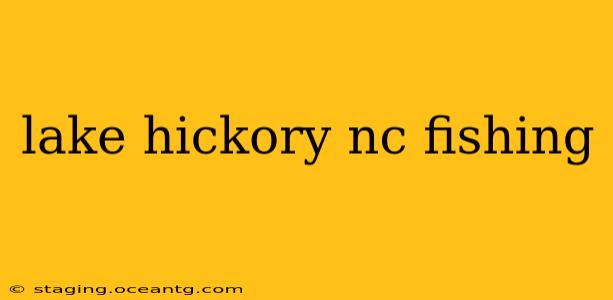Lake Hickory, nestled in the heart of North Carolina, is a haven for fishing enthusiasts. Boasting a diverse population of fish and offering a range of fishing experiences, this reservoir consistently ranks among the top fishing destinations in the state. This comprehensive guide will equip you with the knowledge and insights you need to plan your next successful fishing trip to Lake Hickory.
What kind of fish are in Lake Hickory?
Lake Hickory boasts a healthy and diverse fish population, making it attractive to anglers of all skill levels. The most commonly sought-after species include largemouth bass, striped bass (rockfish), white bass, crappie, and catfish. You'll also find sunfish, bluegill, and other panfish species, providing ample opportunity for a rewarding day on the water. The presence of these varied species makes Lake Hickory a truly versatile fishing destination. The size and abundance of these fish often fluctuate depending on the season and weather conditions.
What is the best time of year to fish Lake Hickory?
The best time to fish Lake Hickory depends largely on the target species. For largemouth bass, spring and fall are generally considered the prime seasons, as water temperatures are ideal for their feeding patterns. Summer can also produce good catches, but anglers often need to adjust their techniques to account for warmer water conditions. Striped bass fishing is typically best in the spring and fall as well. Crappie fishing is excellent during the spring and early summer months. Catfish can be caught throughout the year, although warmer months often yield better results.
What are the best fishing spots on Lake Hickory?
Lake Hickory offers a variety of fishing spots, each with its own unique characteristics. Identifying prime fishing areas often requires understanding water depth, structure, and cover. Areas with submerged trees, rocky points, and drop-offs are often highly productive. However, specific locations are often closely guarded secrets amongst local anglers. Exploring different areas of the lake, observing the activity of other anglers (while maintaining a respectful distance), and experimenting with different techniques is key to finding your own "honey holes."
What are the fishing regulations for Lake Hickory?
Before you cast your line, it's crucial to familiarize yourself with the North Carolina Wildlife Resources Commission's fishing regulations. These regulations specify size and bag limits for various fish species, as well as licensing requirements. Failure to comply with these regulations can result in penalties. Checking the N.C. Wildlife Resources Commission website for the most up-to-date information is essential before your fishing trip.
What kind of bait and lures work best on Lake Hickory?
Lake Hickory anglers employ a diverse range of bait and lures, depending on the target species and the prevailing conditions. For bass, crankbaits, spinnerbaits, and plastic worms are popular choices. Striped bass often respond well to live bait such as shad or herring, or artificial lures that mimic their natural prey. Crappie are often caught using small jigs or minnows. Catfish anglers often use stink bait or live bait such as worms or small fish. Experimentation is key to finding what works best on any given day.
What are some tips for successful fishing on Lake Hickory?
Successful fishing on Lake Hickory, like any body of water, requires preparation and adaptability. Knowing the weather forecast, understanding the lake's structure, and choosing the right bait or lure are critical. Patience is also essential, as fishing is often a waiting game. Consider hiring a local guide for a deeper understanding of the lake's nuances and the best techniques for the time of year. Additionally, respecting the environment and practicing responsible angling are crucial for maintaining the lake's health and beauty for future generations.
This comprehensive guide should provide a strong foundation for your next Lake Hickory fishing adventure. Remember to always check the most current regulations and be prepared to adapt your techniques based on weather conditions and the activity of the fish. Tight lines!
